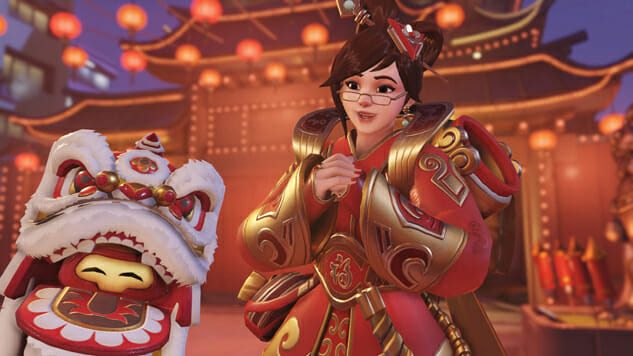
Diversity has been a driving force behind Blizzard and Overwatch since its development, according to a Gamespot interview with lead writer Michael Chu. Its multi-ethnic roster of men, women, robots, and hyper-intelligent apes more accurately reflect our world than the standard white bread protagonists most people assume videogames have. There are 23 playable characters in the team-based shooter’s roster, a super-soldier squad including ten women, ten men, two robots, and a bespectacled gorilla, together representing a multitude of nationalities, races, bionic states, and sexual orientations. A short, squat female Chinese climatologist battles the butch Russian bodybuilder Zarya with a freeze-gun, while Japanese archer Hanzo jettisons arrow after arrow from a rooftop.
On January 24th, Overwatch launched its latest holiday, the Lunar New Year (also known as the Chinese New Year, which is celebrated in much of East Asia), complete with a new Capture the Flag game mode set on their Chinese Lijiang Tower map and a slew of festive unlockables.
Blizzard has made similar gestures with their World of Warcraft events, for example the druidic Lunar Festival of the night elves, the Midsummer celebration common in Northern Europe, and an annual Day of the Dead, commemorating the lives of fallen companions. Clearly the company values its international player base.
The newly-dropped Lunar New Year event runs through February 13 and introduces several thematic unlockables for its characters, like Tracer’s cherry blossom-stylized armor, Symettra’s sidesplit qipao, and Bastion’s bonsai-emblazoned hull. Ana’s Tal (Korean mask) signifies her status as a goofy old woman that still wards off evil while being utterly terrifying to look at, while D.Va’s mini skirt hanbok gives her a bit of a more traditional angle than her typical skin-tight jumpsuit.
Along with these red-and-gold outfits (lucky colors for the New Year), fireworks dot the scenery of Lijiang Tower’s three stages (and also the explosive character Junkrat). The game is building connections across the world through a shared mythology, even the opening fanfare of the Overwatch theme’s harsh brass replaced by the plinking strings of what sounds like a shamisen (a three-stringed Japanese lute) for a more traditional Eastern flair.
On the game’s official site is a link to a visual children’s book in the style of Journey to the West, a story whose influence is felt in Japan, China, and Vietnam while also shaping literature spanning everything from the writing of Neil Gaiman to the male adolescent ubiquity of Dragonball Z.
Hyper-intelligent gorilla Winston read of this tale, that of the “heroic monk Tang Sanzang and his ragtag group of disciples’ quest for redemption, like the banished marshal Zhu Bajie, the old general Sh? Wùjìng, and of course, the mischievous Monkey King, Sun Wukong” while on a moon colony. From high above the Earth, Overwatch’s characters can embrace their culture.
To represent this, Winston’s new skin turns him into Sun Wukong, while Roadhog’s transformation into the piggish Zhu Bajie replaces the vanilla character’s meathook with a creepy glutton’s 9-toothed rake. Reinhardt becomes Sh? Wùjìng, a shovel-wielding monk, while Xuanzang (also referred to as Tang Sanzang) is mapped to the canonically Buddhist Zenyatta. Mei, the only Chinese character, is also the sole character to receive two Legendary skins this release, festive wear that evokes the moon and Journey to the West moon goddess.
The game has a reputation for tastefulness in its approach to diversity, acting as a beacon for other mainstream titles to follow. When the Overwatch webcomic revealed the queerness of one of its most popular characters, Tracer, it wasn’t in an exploitative or tokenized context. It was short, sweet, and breezy, the kind of everyday queerness that normalizes rather than stigmatizes. By taking the same approach to the legends, myths, and celebrations of non-Western cultures, Blizzard encourages acceptance across a global player base.
This attention to detail is smart, not just because research and accuracy are important factors of representation, but also because Blizzard has a huge international audience to please. Back in June of 2016, South Korean internet cafe stat site Gametrics, reported that Overwatch overtook League of Legends as South Korea’s most popular game (though as of this article’s writing, League of Legends has reclaimed the throne with a 1.5% margin). While detailed Chinese player base numbers are hard to find (Blizzard is reticent to release exact figures) , Overwatch unseated Blizzard’s own Diablo III as the fastest-selling PC game in the world’s largest online gaming market. With 2015 reports showing that the LGBTQ community boasted a collective $917 billion in disposable personal income, Overwatch’s continued cultural inclusivity isn’t just international progressivism, it’s good business.
Jacob Oller is a writer and film critic whose writing has appeared in The Guardian, Playboy, Roger Ebert, Film School Rejects, Chicagoist, Vague Visages, and other publications. He lives in Chicago, plays Dungeons and Dragons, and struggles not to kill his two cats daily. You can follow him on Twitter here: @jacoboller.


